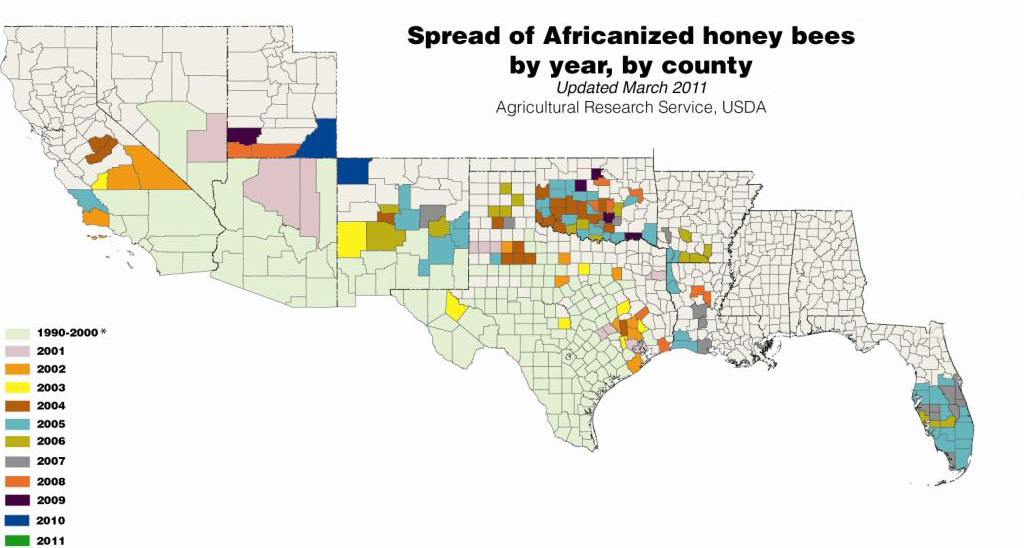Spores of the fungus are ingested with the honey bee larval food. Larvae are most susceptible if they ingest spores when they are 3 to 4 days old and then are chilled briefly 2 days later, immediately after they are sealed in their cells to pupate. The spores germinate in the hind gut of the bee larva, but mycelial (vegetative) growth is arrested until the larva is sealed in its cell. At this stage, the larva is about 6 or …
Why do newly installed packages of bees seem to abscond more than well-established hives?
The difference between a newly installed package of bees and an established hive has to do with the comb (an established have has drawn the comb out and has stores and brood) and the existence of brood in an established hive. Between the drawn comb and the presence of brood bees are very likely to stay put. Installing a package is usually pretty simple and successful. NC State Cooperative Extension has a series of Beekeeping Notes, one of which is …
Does honey have nutritional value?
Honey consists primarily of glucose and fructose (both are carbohydrates) and 17-18% water. Unlike other sweeteners, honey has trace vitamins and minerals including calcium, copper, iron, magnesium, manganese, niacin, pantothenic acid, phosphorus, potassium, riboflavin and zinc. Antioxidants are also found in honey. Flavanoids and phenolic acids found in honey act as antioxidants scavenging and eliminating free radicals. Darker honeys tend to have higher quantities of antioxidants. Honey also makes an effective antimicrobial agent for treating sore throats and other bacterial …
What is raw honey?
It is assumed that raw honey is neither heated nor filtered. As there is no official or legal definition of raw honey, it is possible that a product labeled raw honey may have been heated or filtered. – Nancy Ostiguy, Pennsylvania State University…
If honey becomes crystallized (solid) has it gone ‘bad’?
Honey does not spoil. Crystallized honey is caused by the glucose in liquid honey becoming a solid. Honey can be consumed in its crystallized form or you can warm the honey to dissolve the crystals by placing the jar in warm water and stirring until the crystals disappear. Do not boil or scorch the honey. – Nancy Ostiguy, Pennsylvania State University…
Honey Bee Queens: Evaluating the Most Important Colony Member

Learn what you need to know to have a prolific queen and colony
Authors: Philip A. Moore, Michael E. Wilson, John A. Skinner
Department of Entomology and Plant Pathology, The University of Tennessee, Knoxville TN
Date: August 18, 2015
Introduction
Honey bees (Apis mellifera) are highly social insects and the colony organization is divided into separate castes that allow for division of labor and specialization in particular tasks. The honey bee queen is the sole reproductive female in …
Africanized Bees: Better Understanding, Better Prepared

What you need to know to protect yourself and your bees.
Authors: Philip Moore, Michael Wilson, John Skinner
Department of Entomology and Plant Pathology, the University of Tennessee, Knoxville TN
Date: January 8, 2015
Introduction
The African honey bee (Apis mellifera scutellata) was introduced from the savannahs of eastern and southern Africa to the eucalyptus forests of São Paulo Brazil by Professor Warwick E. Kerr in 1956. Kerr described the colonies as “the most prolific, productive, and industrious …
UMass Extension Symposium: Pollinator Health for Agriculture and Landscapes – March 26, 2015
UMass Extension Symposium: Pollinator Health for Agriculture and Landscapes
March 26, 2015
Campus Center Auditorium, University of Massachusetts, Amherst
8:00 AM Registration and Coffee
8:45 AM Welcome, Anne Averill, Dept. of Environmental Conservation, UMass
9:00 – 10:00 AM Biology, Diversity and Conservation of Native Bees in the Northeast, Joan Milam, Department of Environmental Conservation, UMass
Pollinators are key elements of native biodiversity, and bees in particular provide important ecosystem services in terms of pollination for native plants that support plant …
Cynthia Loftin – University of Maine, USGS

Dr. Loftin is currently studying the spatial analysis of pollination deficit and bee community assessment associated with blueberry fields in Maine. This role includes editing available land cover maps to reflect current landscapes surrounding Maine’s blueberry fields, assessing change in field distribution since the base map was produced, and compiling other spatial data sets to be used in the landscape analysis. Dr. Loftin has been working with the Maine team in the Pollinator Security for Northeastern Crops project to develop …
Bryan Danforth – Cornell University

Dr. Danforth is a professor of Entomology and serves the team as an authority on bees and bee biology; his group has been providing information on the apple pollination system, which allows comparison across all of our crop systems. He has been coordinating research in NY apple and has been rounding out the survey work of the Pollinator Security for Northeastern Crops project by submitting bees from apple orchards and pollen samples for analysis of pathogen identification/prevalence and pesticide loads, …
